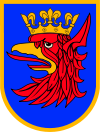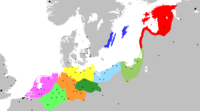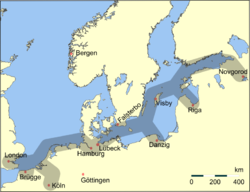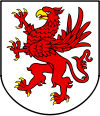Szczecin
- For other meanings, see Szczecin (disambiguation) and Stettin (disambiguation).
| Szczecin | |||
|---|---|---|---|
|
|
|||
|
|||
| Nickname(s): Floating Garden | |||
| Motto: "Szczecin jest otwarty" ("Szczecin is open") |
|||
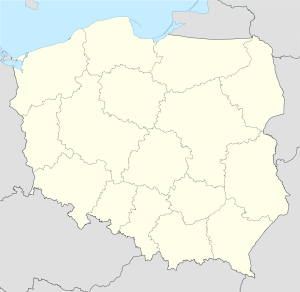 Szczecin
|
|||
| Coordinates: | |||
| Country | |||
| Voivodeship | West Pomeranian | ||
| County | city county | ||
| Established | 8th century | ||
| Town rights | 1243 | ||
| Government | |||
| - Mayor | Piotr Krzystek | ||
| Area | |||
| - City | 301 km2 (116.2 sq mi) | ||
| Population (2009) | |||
| - City | 406,427 | ||
| - Density | 1,350.3/km2 (3,497.1/sq mi) | ||
| - Metro | 777,000 | ||
| Time zone | CET (UTC+1) | ||
| - Summer (DST) | CEST (UTC+2) | ||
| Postal code | PL-70-017 to 71-871 |
||
| Area code(s) | +48 91 | ||
| Car plates | ZS | ||
| Website | http://www.szczecin.pl | ||
Szczecin ([ˈʂt͡ʂɛt͡ɕin] (![]() listen); German: Stettin [ʃtɛˈtɪːn] (
listen); German: Stettin [ʃtɛˈtɪːn] (![]() listen); Kashubian: Sztetëno [ʂtɛˈtənɔ]; Latin: Stetinum, Sedinum), formerly known as Stettin, is the capital city of West Pomeranian Voivodeship in Poland. It is the country's seventh-largest city and the largest seaport in Poland on the Baltic Sea. As of the 2005 census the city had a total population of 420,638. In June 2009 its population was 406,427.
listen); Kashubian: Sztetëno [ʂtɛˈtənɔ]; Latin: Stetinum, Sedinum), formerly known as Stettin, is the capital city of West Pomeranian Voivodeship in Poland. It is the country's seventh-largest city and the largest seaport in Poland on the Baltic Sea. As of the 2005 census the city had a total population of 420,638. In June 2009 its population was 406,427.
Szczecin is located on the Oder River, south of the Lagoon of Szczecin and the Bay of Pomerania. The city is situated along the southwestern shore of Dąbie Lake, on both sides of Oder and on several large islands between western and eastern branch of the river. Szczecin borders with town of Police, seat of the Police County, situated at an estuary of the Oder River.
The city evolved from an early medieval Pomeranian stronghold, which in 1243 was merged with two adjacent German settlements, creating the present-day Old Town. At the site of the former stronghold, a castle was built as a residence of the Griffin dukes, who ruled the Duchy of Pomerania until 1637. In addition to the castle, the Brick Gothic churches were built in the medieval era. These landmarks still dominate the skyline and can be assessed via the European Route of Brick Gothic. Four important treaties were concluded in the town, the Treaty of Stettin (1570) ending the Northern Seven Years' War, the Treaty of Stettin (1630) settling the conditions of Swedish occupation of the Duchy of Pomerania during the Thirty Years' War, the Treaty of Stettin (1653) settling the border between Brandenburg-Prussian and Swedish Pomerania after the war, and Frederick I of Prussia and George I of Great Britain concluded an alliance in the Treaty of Stettin (1715) during the Great Northern War.
Stettin remained with Sweden until the Treaty of Stockholm (1720), when it was integrated into the Brandenburg-Prussian part of Pomerania. From 1815 to 1945, the city was the capital of both the reorganized Prussian Province of Pomerania and of its central government region. Stettin became the largest and most industrial city of the province, and the surrounding towns and villages were subsequently amalgamated. After the Second World War, the city was annexed by Poland, and its inhabitants fled or were forcibly expelled. Subsequently, the devastated town was rebuilt by Polish settlers. Szczecin became the capital of the Szczecin Voivodeship, which in 1999 was merged into the West Pomeranian Voivodeship.
Contents |
Name and its etymology
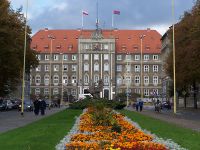

.jpg)
The names "Szczecin" and "Stettin" as well as the names of town's neighbourhoods and oldest districts are of Slavic origins, however the exact words upon which it is based on is subject of ongoing research[1]
Spelling variants in medieval sources include:
- Stetin,[2] recorded e.g. in 1133,[2] 1159,[2] 1177[2]
- Stetyn,[2] recorded e.g. in 1188,[2] 1243[2]
- Stetina,[2] by Herbord[2]
- Stetinum and Sedinum, still used in contemporary Latin language references
- Stitin, recorded e.g. in 1251,[2] in the Annales Ryensis,[2] in 1642[3]
- Stitinum, by Saxo Grammaticus[2]
- Stittinum
- Stytin,[2] in the Annales Colbacensis[2]
Other medieval names are:
These names, literally "brush burgh", most possibly are derived from the translation of the city's Slavic name.[4]
Maria Malec in Etymological dictionary of geographical names of Poland has counted 11 distinct theories regarding the origin of the name, that may be derived from
- hill peak (Polish: szczyt)
- grass (Polish: szczeć = Dipsacus)
- a personal name (Szczota)[5]
Historian Marian Gumowski (1881–1974) argued, based on his studies of early city stamps and seals, that the earliest name of the town was, in modern Polish spelling, Szczycin.[6][7]
In 1310, Wartislaw IV, Duke of Pomerania founded the city of Neustettin ("New Stettin", now Szczecinek). For distinction, the town was called Alten Stettin, Alten-Stettin or Altenstettin[8] ("Old Stettin").
History
Middle Ages
A.png)
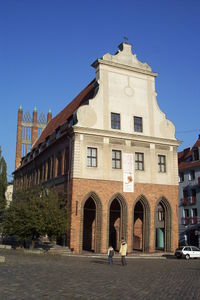
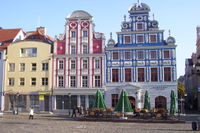
The history of Szczecin began in the 8th century, when West Slavs settled Pomerania and erected a stronghold on the site of the modern castle.[9] Since the 9th century, the stronghold was fortified and expanded toward the Oder bank.[9] Mieszko I of Poland and Piast rulers took control of parts of Pomerania between the 960s and 1005, but not of the lower Oder region.[10][11] Subsequent Polish rulers, the Holy Roman Empire and the Liutician federation aimed at control of the territory.[1]
After the decline of neighboring regional center Wolin in the 12th century, the settlement became one of the more important and powerful seaports of the Baltic Sea south coasts.
In a campaign in the winter of 1121–1122,[12] Bolesław III Wrymouth, the Duke of Poland, gained control of the region and the stronghold.[1][13][14][15][16][17]
The inhabitants were converted to Christianity[1] by two missions of bishop Otto of Bamberg in 1124 and 1128.[18] At this time, the first Christian church of St. Peter and Paul was erected. Polish minted coins were commonly used in trade in this period.[1]
Polish supremacy ended with Boleslaw's death in 1138.[19] During the Wendish Crusade in 1147, a contingent led by the German margrave Albert the Bear, an enemy of Slavic presence in the region,[1] papal legat Anselm of Havelberg and bishop Konrad of Meißen sieged the town.[20][21][22][23] There, a Polish contingent supplied by Mieszko III the Old[24][25] joined the crusaders.[20][21] However the citizens had placed crosses around the fortifications,[26] indicating they already had been Christianized.[1][27] Ratibor I, Duke of Pomerania, negotiated the disbandement of the crusading forces.[20][21][28]
After the Battle of Verchen in 1164, Stettin duke Bogislaw I became a vassal of the Saxony's Henry the Lion.[29] In 1173, Stettin castellan Wartislaw II could not resist a Danish attack and became vassal of Denmark.[29] In 1181, duke Bogislaw I of Stettin became a vassal of the Holy Roman Empire.[30] In 1185, the dukes were again vassals of Denmark.[30] The burgh was manned with a Danish force and reconstructed in 1190.[31] The empire restored her superiority in the Battle of Bornhöved in 1227.[30]
In the second half of the 12th century, a group of German tradesmen ("multus populus Teutonicorum"[32] from various parts of the Holy Roman Empire) settled in the city around St. Jacob's Church, which was donated in 1180[32] by Beringer, a trader from Bamberg, and consecrated in 1187.[32][33] Hohenkrug (now in Szczecin-Struga) was the first village in the Duchy of Pomerania clearly recorded as German (villa teutonicorum) in 1173.[34] German settlement (Ostsiedlung) accelerated in Pomerania during the 13th century.[35] Duke Barnim of Pomerania granted a local government charter to this community in 1237, separating the German settlement from the Slavic community settled around the St. Nicholas Church in the neighborhood of Kessin (Polish: Chyzin). In the charter, the Slavs were put under German jurisdiction.[36]
When Barnim granted Stettin Magdeburg Law in 1243, the old Slavic settlement with its burgh was included within the city limits, which is exceptional for Pomeranian towns usually not comprising former Slavic settlements or burghs, though sometimes founded in close proximity.[37] The former Slavic settlement was dissolved when, after the town was placed under German town law, the duke had to promise to level the burgh in 1249.[38] Most Slavic inhabitants were resettled to two new suburbia (German: Wieken) north and south of the town.[39] Last records of Slavs in Stettin are from the 14th century, when a Slavic bath (1350) and bakery are recorded, and within the walls, Slavs lived in a street named Schulzenstrasse.[40] By the end of the century, the remaining Slavs had been assimilated.[41]
In 1249, Barnim granted town law also the town of Damm (also Altdamm) on the eastern bank of the Oder,[42][43] which only on 15 October 1939 was merged to neighboring Stettin and is now the Szczecin-Dąbie neighborhood.[44] This town had been built on the site of a former Pomeranian burg, "Vadam" or "Dambe", which Boleslaw had destroyed during his 1121 campaign.[43]
Stettin joined the Hanseatic League in 1278. The anti-Slavic policies of German merchants and craftsmen intensified in this period, resulting in bans on people of Slavic descent joining craft guilds, or even bans against public usage of native Slavic language.[1] In Szczecin, richer Slavic citizens were forcefully stripped of their possessions which were awarded to Germans.[1]
While not as heavily affected by medieval witchhunts as other regions of the empire, there are reports of the burning of three women and one man convicted of witchcraft in 1538.[45]
Modern Age
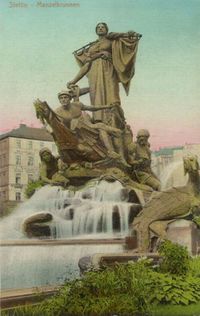
In 1570, during the reign of Pomeranian duke Johann Friedrich, a congress was held at Stettin ending the Northern Seven Years' War. During the war, Stettin had tended to side with Denmark, while Stralsund tended toward Sweden - as a whole, the Duchy of Pomerania however tried to maintain neutrality.[46] Nevertheless, a Landtag that had met in Stettin in 1563 introduced a sixfold rise of real estate taxes to finance the raising of a mercenary army for the duchy's defense.[46] Johann Friedrich also succeeded in elevating Stettin to one of only three places allowed to coin money in the Upper Saxon Circle of the Holy Roman Empire, the other two places were Leipzig and Berlin.[47]
The early deaths of several Pomeranian dukes in the beginning 17th century gave rise to superstitions, resulting in the witch trial and conviction of 72-year old noble Sidonia von Borcke in 1620.[48][49] She was decapitated and her body burned in Stettin, outside the mill gate. Bogislaw XIV, who resided in Stettin since 1620, became the sole, and last Griffin duke when Philipp Julius died in 1625. Before the Thirty Years' War reached Pomerania, Stettin as all of the duchy declined economically due to the sinking importance of the Hanseatic League and a conflict between Stettin and Frankfurt (Oder).[49]
Since the Treaty of Stettin of 1630, the town along with most of Pomerania was allied to and occupied by the Swedish Empire, who managed to keep the western parts of Pomerania after the death of Bogislaw XIV in 1637 and the Peace of Westphalia in 1648, despite the protests of Elector Frederick William of Brandenburg, who had a legal claim to inherit all of Pomerania. The exact partition of Pomerania between Sweden and Brandenburg was settled in Stettin in 1653. In 1720, after the Great Northern War, the Swedes were forced to cede the city to King Frederick William I of Prussia.
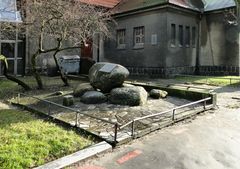
After Franco Prussian war of 1870-1871, 1700 French POWs were imprisoned here, in deplorable conditions and as result 600 of them died[51];after Second World War monuments in their memory were build by Polish authorities.
Stettin developed into a major Prussian city and became part of the Prussian-led German Empire in 1871.
On 20th October 1890 Poles created Towarzystwo Robotników Polsko Katolickich(Society of Polish-Catholic Workers) in the city, one of the first Polish organisations[52] According to German data(which most likely reduced the numbers) Poles accounted for 10.500 in Szczecin(Stettin) area in 1910 [53] Before the outbreak of the World War in 1914 the Polish population in the city itself numbered 3,000 people,[1] including a few wealthy industrialists and merchants, before World War I. Among them was Kazimierz Pruszak, director of industrial works Gollnow, and a Polish patriot who predicted eventual return of Szczecin to Poland.[1]
In 1935 the German Wehrmacht made Stettin the headquarters for Wehrkreis II, which controlled the military units in all of Mecklenburg and Pomerania. It was also the Area Headquarters for units stationed at Stettin I and II; Swinemünde; Greifswald; and Stralsund.
In 1939 Stettin had about 400,000 inhabitants, the surrounding villages were included into "Groß-Stettin". It was Germany's third-biggest seaport (after Hamburg and Bremen) and was of great importance for the supply and trade of Berlin. Cars of the Stoewer automobile company were produced in Stettin from 1899 - 1945.
In the interwar period the Polish presence fell from 3,000 people to 2,000 people.[1] Nevertheless the Polish minority remained active despite repressions.[1][54] A number of Poles were members of Union of Poles in Germany which was established in the city in 1924[55], a Polish scouts team was established.[1] Additionally a Polish school was created where Polish language was taught. Repressions, intensified especially after Adolf Hitler came to power led to closing of the school.[1] Members of Polish community who took part in cultural and political activities were persecuted and even murdered. In 1938 the head of Szczecin’s Union of Poles unit Stanisław Borkowski was imprisoned in Oranienburg.[1] In 1939 all Polish organisations in Szczecin were disbanded by German authorities and during the war teachers from Polish school, Maksymilian Golisz and Omieczyński murdered.[1]
During the 1939 invasion of Poland, which started World War II in Europe, Stettin was the base for the German 2nd Motorized Infantry Division, which cut across the Polish Corridor.
As the war started the number of non-Germans in the city increased as slave workers were brought in. The first transports came in 1939 from Bydgoszcz, Toruń and Łódż. They were mainly used in synthetic silk factory near Szczecin.[1] Next wave of slave workers was brought in 1940 in addition to PoWs who were used to work in agricultural industry.[1] According to German police reports from 1940 the Polish population in the city reached 15,000 people, while 25,000 foreigners were registered in general.[1]
In February 1940, the Jews of Stettin were deported to the Lublin reservation. International press reports emerged writing how the Nazis forced Jews regardless of age, condition and gender to sign away all property-including wedding rings-and loaded on trains escorted by SA and SS. Due to publicity of the event, German institutions ordered such actions in the future to be made in a way not arousing public notice.[56]
During the war 135 work camps for slave workers were established in the city. Most of the slave workers were Poles, besides them Czechs, Italians, Frenchmen and Belgians as well Dutch were served in the camps.[1]
Allied air raids in 1944 and heavy fighting between the German and Soviet armies destroyed 65% of Stettin's buildings and almost all of the city centre, seaport and industries. In April 1945 the authorities of the city issued an order of evacuation and most of the city’s German population fled.
post-World War II
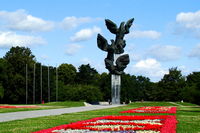
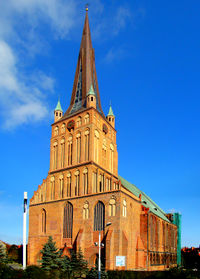
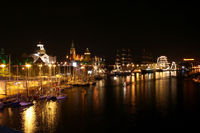
The Soviet Red Army captured the city on 26 April 1945. Many of the city's inhabitants fled before its capture, and Stettin was virtually deserted when it fell, with only 6,000 Germans in the city when Polish authorities took control.[1] In the following month the Polish administration was forced to leave again twice. Finally the permanent handover occurred on 5 July 1945.[57] In the meantime part of the German population had returned, believing it might become part of the Soviet occupation zone of Germany[58] and the Soviet authorities had already appointed the German Communists Erich Spiegel and Erich Wiesner as mayors.[59] Stettin is located mostly west of the Oder river, which was considered to become Poland's new border. Because of the returnees, the German population of the town swelled to 84,000 again.[58] The mortality rate was at 20%, primarily due to starvation.[60] However, Stettin and the mouth of the Oder River (German: Stettiner Zipfel), also became Polish as already stated in Treaty signed on 26 VII 1944 between Soviet Union and PKWN and confirmed during Potsdam Conference.[1] On 4 October 1945, the decisive land border of Poland was laid out west of the 1945 line,[1][61] but excluded the Police (Pölitz) area, the Oder river itself and the Szczecin port, which remained under Soviet administration.[61] The Oder river was handed over to Polish administration in September 1946, and the port was subsequently handed over between February 1946 and May 1954.[61]
The Polish authorities were led by Piotr Zaremba.[60] Many remaining Germans were forced to work in Soviet military camps that were outside of Polish jurisdiction. In Stettin-Scheune, a transit camp for German expellees was set up, infamous for looting and rapes.[62]
In 1945 the Polish community in Stettin consisted of forced labourers from the General government. Contemporary to the expulsion of the German population, Stettin was resettled with Poles. Additional Poles were moved to the city from Polish areas annexed by the Soviet Union. This settlement process was coordinated by the city of Poznań, and Stettin was from then on known by the Polish name Szczecin. The town was then used in 1946 as the northern end for what Winston Churchill called the iron curtain. In 1947, after Operation Vistula, a significant number of Ukrainians came to Szczecin, having been forced by the Communist government to leave eastern Poland.
The new citizens of Szczecin rebuilt and extended the city's industry and industrial areas, as well as its cultural heritage, although efforts were hampered by the authorities of Communist Poland. Szczecin became a major Polish industrial centre and an important seaport (particularly for Silesian coal) for both Poland, Czechoslovakia, and East Germany. The city witnessed anti-communist revolts in 1970 and 1980 and participated in the growth of the Solidarity movement during the 1980s. Since 1999 Szczecin has been the capital of the West Pomeranian Voivodeship.
Historical population
- 12th century: 5,000 inhabitants
- 1709: 6,000 inhabitants[63]
- 1711: 4,000 inhabitants (Black Death)[63]
- 1720: 6,000 inhabitants
- 1740: 12,300 inhabitants
- 1816: 21,500 inhabitants
- 1816: 26,000 inhabitants[64]
- 1843: 37,100 inhabitants
- 1861: 58,500 inhabitants
- 1872: 76,000 inhabitants
- 1875: 80,972 inhabitants[65]
- 1890: 116,228 inhabitants[65]
- 1900: 210,680 inhabitants (including amalgated suburbs)
- 1910: 236,113 inhabitants[65]
- 1939: 382,000 inhabitants
- 1945: 260,000 inhabitants (majority of the German population fled the advancing Red Army or was later expelled)
- 1950: 180,000 inhabitants (drop due to continuing expulsions of Germans; arrival of Polish and Jewish settlers, partially from the Polish territories annexed by the Soviet Union [66] as well as some Polish citizens of the Ukrainian descent;[67] see also "Recovered Territories", Repatriation of Poles (1944–1946), Operation Vistula)
- 1960: 269,400 inhabitants
- 1970: 338,000 inhabitants
- 1975: 369,700 inhabitants
- 1980: 388,300 inhabitants
- 1990: 412.600 inhabitants
- 1995: 418.156 inhabitants
- 2000: 415,748 inhabitants
- 2002: 415,117 inhabitants
- 2003: 414,032 inhabitants
- 2004: 411,900 inhabitants
- 2005: 411,119 inhabitants
- 2007: 407,811 inhabitants
Architecture and urban planning
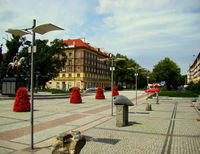
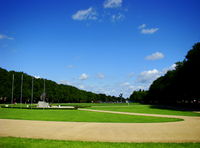
Szczecin's architectural style is mainly influenced by those of the last half of the 19th century and the first years of the 20th century: Academic art and Art Nouveau. In many areas built after 1945, especially in the city centre, which had been destroyed due to Allied bombing, social realism is prevalent.
Urban planning of Szczecin is unusual. The first thing observed by a newcomer is abundance of green areas: parks and avenues – wide streets with trees planted in the island separating opposite traffic (where often tram tracks are laid); and roundabouts. Thus, Szczecin's city plan resembles that of Paris. This is because Szczecin was rebuilt in the 1880s according to a design by Georges-Eugène Haussmann, who had redesigned Paris under Napoléon III.
This course of designing streets in Szczecin is still used, as many recently built (or modified) city areas include roundabouts and avenues.
Within Szczecin's boundaries is part of the protected area called Szczecin Landscape Park in the forest of Puszcza Bukowa.
Municipal administration
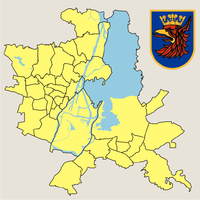
The city is administratively divided into boroughs (Polish: dzielnica), which are further divided into smaller neighbourhoods. The governing bodies of the latter serve the role of auxiliary local government bodies called Neighborhood Councils (Polish: Rady Osiedla). Elections for Neighborhood Councils are held up to six months after each City Council elections. Attendance is rather low (on 20 May 2007 it ranged from 1.03% to 27.75% and was 3.78% on average). Councillors are responsible mostly for small infrastructure like trees, park benches, playgrounds, etc. Other functions are mostly advisory. Official list of districts
Dzielnica Śródmieście (City Centre) Centrum, Drzetowo-Grabowo, Łękno, Międzyodrze-Wyspa Pucka, Niebuszewo-Bolinko, Nowe Miasto, Stare Miasto, Śródmieście Północ, Śródmieście-Zachód, Turzyn.
Dzielnica Północ (North) Bukowo, Golęcino-Gocław, Niebuszewo, Skolwin, Stołczyn, Warszewo, Żelechowa.
Dzielnica Zachód (West) Głębokie-Pilchowo, Gumieńce, Krzekowo-Bezrzecze, os.Arkońskie-Niemierzyn, Osów, Pogodno, Pomorzany, Świerczewo, os.Zawadzkiego-Klonowica.
Dzielnica Prawobrzeże (Right-Bank) Bukowe-Klęskowo, Dąbie, Majowe-Kijewo, Płonia-Śmierdnica-Jezierzyce, Podjuchy, os.Słoneczne, Wielgowo-Sławociesze, Załom, Zdroje, Żydowce-Klucz.
Other historical neighborhoods
Babin, Barnucin, Basen Górniczy, Błędów, Boleszyce, Bystrzyk, Cieszyce, Cieśnik, Dolina, Drzetowo, Dunikowo, Glinki, Grabowo, Jezierzyce, Kaliny, Kępa Barnicka, Kijewko, Kluczewko, Kłobucko, Kniewo, Kraśnica, Krzekoszów, Lotnisko, Łasztownia, Niemierzyn, Odolany, Oleszna, Podbórz, Port, os.Przyjaźni, Rogatka, Rudnik, Sienna, Skoki, Słowieńsko, Sosnówko, Starków, Stoki, Struga, Śmierdnica, os.Świerczewskie, Trzebusz, Urok, Widok, Zdunowo.
Members of European Parliament (MEPs) from Szczecin
- Zdzisław Chmielewski, PO, historian, former rector of University of Szczecin.
- Bogusław Liberadzki, SLD-UP, economist, minister of transport.
- Sylwester Chruszcz, LPR, architect and politician, elected in Silesian constituency, but lives in Szczecin.
Economy
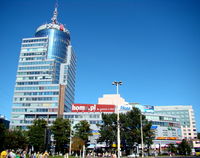
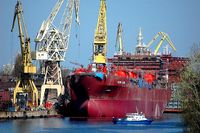

Szczecin has three shipyards (Stocznia Remontowa Gryfia, Stocznia Pomerania, Stocznia Szczecińska), of which one is the biggest in Poland (Stocznia Szczecińska, which five years ago went bankrupt and was reinstated). It has a fishing industry and a steel mill. It is served by Szczecin-Goleniów "Solidarność" Airport and by the Port of Szczecin, third biggest port of Poland. It is also home to several major companies. Among them is the major food producer Drobimex, Polish Steamship Company, producer of construction materials Komfort, Bosman brewery and Cefarm drug factory. It also houses several of the new business firms in the IT sector.
Transportation
There is a popular public transit system operating throughout Szczecin, including a bus network and electric trams, that is run by ZDiTM.
The A6 motorway (recently upgraded) serves as the southern bypass of the city, and connects to the German A11 autobahn (portions of which are currently undergoing upgrade), from where one can reach Berlin in about 90 minutes (about 150 km). Road connections with the rest of Poland are of lower quality (no motorways), though the Express Road S3 that is currently under construction will begin to improve the situation after its stretch from Szczecin to Gorzów Wielkopolski is opened around 2010. Construction of Express Roads S6 and S10 which are to run east from Szczecin has also started, though these roads will not be fully completed until about 2015.
Szczecin has good railway connections with the rest of Poland, but it is connected by only two single track, non-electrified lines with Germany to the west (high quality double-track lines were degraded after 1945). Because of this, the rail connection between Berlin and Szczecin is much slower and less convenient than one would expect between two European cities of that size and proximity.
Szczecin is served by Szczecin-Goleniów "Solidarność" Airport which is 45 km northeast of the city.
Culture
Major cultural events in Szczecin are:
- Days of the Sea (Polish Dni Morza) held every June.
- Street Artists' Festival (Polish Festiwal Artystów Ulicy) held every July.
- Days of The Ukrainian Culture (Polish Dni Kultury Ukraińskiej) held every May.
- Air show on Dabie airport held every May.
Museums
- National Museum in Szczecin (Polish Muzeum Narodowe w Szczecinie) collects arts, old jewelry, military equipment. It has three branches:
- Museum of the City of Szczecin (Polish Muzeum Miasta Szczecina) in the Old City Town Hall, Szczecin.
- Maritime Museum (Polish Muzeum Morskie).
- Gallery of Contemporary Arts (Polish Galeria Sztuki Współczesnej).
- Museum of the Szczecin Archidiocese (Polish Muzeum Archidiecezjalne w Szczecinie) collects sacral arts and historical documents.
- EUREKA - the miracles of science. EUREKA
Arts and entertainment
- Bismarck tower Szczecin
- Kana Theatre (Polish Teatr Kana)
- Modern Theatre (Polish Teatr Współczesny)
- Opera in the Castle (Polish Opera na Zamku)
- Polish Theatre (Polish Teatr Polski)
- (ruins of) The Quistorp's Tower (Polish Wieża Quistorpa, German Quistorpturm)
- The Pomeranian Dukes' Castle in Szczecin (Polish Zamek Książąt Pomorskich w Szczecinie)
- The Castle Cinema (Polish Kino Zamek)
- The Cellar by the Vault Cabaret (Polish Kabaret Piwnica przy Krypcie)
- The Crypt Theatre (Polish Teatr Krypta)
- The Pleciuga Puppetry Theatre (Polish Teatr Lalek Pleciuga)
Education and science

- University of Szczecin (Polish Uniwersytet Szczeciński) with 35.000 students, rector Waldemar Tarczyński
- West Pomeranian University of Technology (Polish: Zachodniopomorski Uniwersytet Technologiczny)
- Pomeranian Medical University (Polish Pomorska Akademia Medyczna)
- Branch of Academy of Music in Poznań (Polish Akademia Muzyczna w Poznaniu)
- Maritime University of Szczecin (Polish Akademia Morska w Szczecinie)
- The West Pomeranian Business School (Polish Zachodniopomorska Szkoła Biznesu)
- Higher School of Public Administration in Szczecin (Polish Wyższa Szkoła Administracji Publicznej w Szczecinie)
- High Theological Seminary in Szczecin (Polish Arcybiskupie Wyższe Seminarium Duchowne w Szczecinie)
- Higher School of Applied Arts (Polish Wyższa Szkoła Sztuki Użytkowej)
- Academy of European Integration (Polish Wyższa Szkoła Integracji Europejskiej)
- Wyższa Szkoła Ekonomiczno-Turystyczna
- Wyższa Szkoła Humanistyczna TWP
- Wyższa Szkoła Języków Obcych
- Wyższa Szkoła Techniczno-Ekonomiczna
- Wyższa Szkoła Zawodowa- Collegium Balticum
- Wyższa Szkoła Zawodowa "OECONOMICUS" PTE
- Wyższa Szkoła Zarządzania
Scientific and regional organizations
- Western Pomeranian Institute (Polish Instytut Zachodnio-Pomorski)
- Szczecin Scientific Society (Polish Szczecińskie Towarzystwo Naukowe)
Sports
There are many popular professional sports team in Szczecin area. The most popular sport today is probably football (thanks to Pogoń Szczecin just promoted to play in the 1st league in season 2004/2005). Amateur sports are played by thousands of Szczecin citizens and also in schools of all levels (elementary, secondary, university).
Professional teams
- Pogoń Szczecin - football team (2nd league in season 2008/2009)
- STK Wilki Morskie Szczecin - basketball team
- Arkonia Szczecin - football team (5th league in season 2008/2009)
- Pogoń II Szczecin - 2nd Pogoń football team (regional 6th league in season 2008/2009)
- KS Stal Szczecin - 15 youth and junior teams, 1 senior, being in 4th regional league in season 2008/2009
- Pogoń '04 Szczecin - futsal team (1st league of Polish futsal in season 2008/2009)
- KS Piast Szczecin - women's volleyball team, (Seria A in season 2003/2004 and 2004/2005)
- Pogoń Handball Szczecin - handball men and women teams playing in 2nd Polish Handball League
- Wicher Warszewo - futsal team playing in Środowiskowa Liga Futsalu (Futsal League) - 2 regional Futsal League: 2nd place in 2006/2007 season - promotion in the first regional Futsal League
- Husaria Szczecin - American football team playing in Polish American Football League
Amateur leagues
- Halowa Amatorska Liga Pilkarska - Hall Amateur Football League [5]
- Halowa Liga Pilki Noznej- Hall Football League
- Szczecinska Liga Amatorskiej Koszykowki - Szczecin Amateur Basketball League [6]
- Szczecinska Amatorska Liga Pilki Siatkowej - Szczecin Amateur Volleyball League [7] - women league, 1st, 2nd and 3rd men league
- Elita Professional Sport - Elita Hall Football League [8] - 1st and 2nd league, futsal cup
- Kaskada Szczecin Rugby Club - club rugby [9] - 7 and 15 league, rugby cup
International relations
Twin towns — Sister cities
The twin towns and sister cities of Szczecin are:
Famous residents
Before 1945
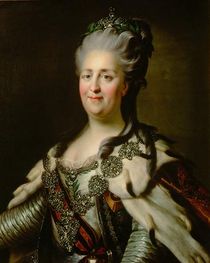
- Ernst Bader, 7 June 1914, - 10 August 1999 (actor and songwriter)
- Johannes Theodor Baargeld, 9 October 1892 - 16 August or 17, 1927, (painter and poet)
- Max Berg, 17 April 1870 - 22 January 1947, (Architect)
- Michael Bürsch, b. 3 June 1942 (Politician)
- Catherine the Great (1729–1796), empress of Russia, born in Stettin in 1729
- Heinrich Philipp August Damerow (1798–1866), psychiatrist
- Helga Deen, 6 April 1925 - 16 July 1943
- Alfred Döblin (1878–1957), writer
- Carl August Dohrn (1806–1892), entomologist
- Felix Anton Dohrn, 29 September 1840 - 26 September 1909, first director of the Stazione Zoologica, Naples, Italy.
- Philipp Dulichius (1562–1631), German composer
- Sophie Marie Dorothea Auguste Louise of Württemberg (1759–1828), the second wife of Tsar Paul I of Russia
- Fritz Gerlich, 15 February 1883 - 30 June 1934, journalist
- Heinrich George (1893–1946), actor born in Stettin on 9 October 1893
- Otto von Gierke, 11 January 1841 - 10 October 1921, historian
- Friedrich Gilly (1772–1800), architect
- Wolf Gold (1889–1956), rabbi
- Hermann Günther Grassmann (1809–1877) mathematician, physicist, linguist, scholar, and neohumanist
- Hermann Julius Grüneberg (1827–1894), chemist born in Stettin on 11 April 1827
- Oscar Hammerstein I (1847–1919), composer
- Carl Gustav Friedrich Hasselbach (1809–1882), mayor of Magdeburg
- Theodor Hildebrandt, 2 July 1804 - 1874, painter
- Michael Holm, 29 July 1943, singer and songwriter
- Leon Jessel, 22 January 1871 - 4 January 1942, composer
- Knut Kiesewetter, born 13 September 1941, musician
- Franz Theodor Kugler, 19 January 1808 - 18 March 1858, art historian
- Kurt Kuhnke (1910—1969), motorcyclist
- Monika Lennartz (born in 1938), actress with the Maxim Gorki Theater in Berlin
- Carl Loewe (1796–1869) composer, lived in Stettin
- A. F. Marx (1838–1904), publisher
- Traugott Konstantin Oesterreich (1880–1949), religious parapsychologist and philosopher
- Wolfhart Pannenberg (born 1928), Christian theologian
- Dita Parlo, 4 September 1906 - 13 December 1971, film actress
- Robert Prutz, 30 May 1816 - 21 June 1872, poet
- Franz San Galli (1824–1908), inventor of radiator (central heating system)
- Werner Seelenbinder, 2 August 1904 - 24 October 1944, politician
- Manfred Stolpe (born 1936), former Prime Minister of Brandenburg and Federal Minister in the government of Gerhard Schröder (2002–2005)
- Carl Ludwig Schleich (1859–1922), author
- Christian Tomuschat (born 1936), expert in international law, professor at the Humboldt University of Berlin
- Hans Heinrich von Twardowski, 5 May 1898 – 19 November 1958, film actor
- Friedrich Graf von Wrangel (1784–1877), Prussian Field Marshal
- Ernst Zitelmann, 7 August 1852 - 28 November 1923, jurist
After 1945
- Chava Alberstein (*1947), Israeli female singer and composer of songs
- Piotr Andrejew (*1947), Polish screenwriter and film director, born in Szczecin
- Konstanty Ildefons Gałczyński (1905–1953)
- Janusz Kijowski (*1947) film director, born in Szczecin
- Ryszard Kotla (*1947) historian, travel writer, journalist, engineer, born in Szczecin-Dąbie
- Wojciech Kulikowski artist (1954)
- Mariusz Ratajczak (*1955) Polish hematologist
- Kasia Nosowska (*1971), singer of Szczecin-based rock band Hey
- Radoslaw Majdan Poland National Goalkeeper
- Grzegorz Mroz (*18 December 1983)
- Klaudia Ungerman (*1988), Miss Poland 2008
- Anna Tarnowska (*1986), first runner-up Miss Polonia 2007, second runner-up Miss International 2008
- Joanna Drozdowska (*1979), Miss Polonia 2001, model, fotomodel
- Joanna Gapińska (*1968), Miss Polonia 1988, 3rd runner-up Miss Universe 1989
- Jerzy Zielinski (*1950) Polish cinematographer active in Hollywood, born on 8 January 1950 in Szczecin
- Rafal Wilk (*June 20, 1983), motorsports
- Maksymilian Lewandowski (*1991), Mister Poland 2010
- Alex Furmańczyk Mister Poland Model 2010
Panorama
OZach-panoramic-fragment.jpg)
See also
- Towns near Szczecin: Stargard Szczeciński, Police, Poland, Gryfino, Goleniów, Pyrzyce, Cedynia, Chojna, Mieszkowice, Moryń, Trzcińsko-Zdrój, Nowe Warpno, Penkun (Germany), Pasewalk (Germany), Eggesin (Germany), Gartz (Germany)
- Villages near Szczecin: Kolbacz, Przęsocin, Kołbaskowo
- Szczecin Lagoon
- Wkrzanska Forest
- Central Cemetery in Szczecin
References
Bibliography
- Encyclopedia of Szczecin. Vol. I, A-O. Szczecin: University of Szczecin, 1999, ISBN 83-87341-45-2 (pl)
- Encyclopedia of Szczecin. Vol. II, P-Ż. Szczecin: University of Szczecin, 2000, ISBN 83-7241-089-5 (pl)
- Jan M. Piskorski, Bogdan Wachowiak, Edward Włodarczyk, A short history of Szczecin, Poznań 2002, ISBN 83-7063-332-3 (pl)
- W. H. Meyer, Stettin in alter und neuer Zeit, Stettin, 1887 (de)
Notes
- ↑ 1.00 1.01 1.02 1.03 1.04 1.05 1.06 1.07 1.08 1.09 1.10 1.11 1.12 1.13 1.14 1.15 1.16 1.17 1.18 1.19 1.20 1.21 1.22 1.23 Tadeusz Białecki, "Historia Szczecina" Zakład Narodowy im. Ossolińskich, 1992 Wrocław. Pages 9,20-55, 92-95, 258-260, 300-306
- ↑ 2.00 2.01 2.02 2.03 2.04 2.05 2.06 2.07 2.08 2.09 2.10 2.11 2.12 2.13 2.14 2.15 Gerard Labuda, Władysław Filipowiak, Helena Chłopocka, Maciej Czarnecki, Tadeusz Białecki, Zygmunt Silski, Dzieje Szczecina 1-4, Państwowe Wydawn. Nauk., 1994, p.14, ISBN 8301043423
- ↑ Merians anmüthige Städte-Chronik, das ist historische und wahrhaffte Beschreibung und zugleich Künstliche Abcontrafeyung zwantzig vornehmbster und bekantester in unserm geliebten Vatterland gelegenen Stätte, 1642
- ↑ 4.0 4.1 4.2 Stanisław Rospond, Slawische Namenkunde Ausg. 1, Nr. 3, C. Winter, 1989, p.162
- ↑ Słownik etymologiczny nazw geograficznych Polski Profesor Maria Malec PWN 2003
- ↑ Zdzisław Kaczmarczyk, Problematyka polsko-niemiecka i polskich Ziem Zachodnich w badaniach Uniwersytetu im. Adama Mickiewicza w Poznaniu (1919-1969), Wydawnictwo Naukowe Uniwersytetu im. Adama Mickiewicza w Poznaniu, 1971, pg 134
- ↑ Poznańskie Towarzystwo Przyjaciół Nauk Wydział Filologiczno-Filozoficzny, Slavia occidentalis, 1974, pg. 13
- ↑ Examples for this usage are: Kirchen Visitatio zu Alten-Stettin, Bescheid und Ordnung, 1535; Resolution des Ausschusses der Stände, Altenstettin 1595; Daniel Cramer, Pommerische Kirchen Chronica, Alten-Stettin 1603; Friedeborn, Histor. Beschreibung der Stadt Alten-Stettin in Pommern., 1613; Aulicae vitae Institutiones, Alten Stettin 1693; Christoph Tetzloff, Die stetige Zuflucht eines Gottesmenschen zum Herrn, Alten-Stettin, 1719; M. Stephani, Von der Pest und andern Kranckheiten, Alten-Stettin 1734
- ↑ 9.0 9.1 Jan M Piskorski, Pommern im Wandel der Zeit, 1999, p.52, ISBN 839061848
- ↑ Jan M Piskorski, Pommern im Wandel der Zeit, 1999, pp.31,32, ISBN 839061848
- ↑ Paul W. Knoll, Frank Schaer, annotaded Gesta Principum Polonorum: The Deeds of the Princes of the Poles by Gallus, Central European University Press, 2003, p.32, ISBN 9639241407: "It is assumed that Mieszko I some time before 967 defeated the Wolinians, [...] but could not conquer the estituary of the Oder River; no campaign of Boleslaw I to that region is known."
- ↑ Jan M Piskorski, Pommern im Wandel der Zeit, 1999, p.36, ISBN 839061848
- ↑ Jan M Piskorski, Pommern im Wandel der Zeit, 1999, pp.31,36,43 ISBN 839061848: p.31 (yrs 967-after 1000 AD):"[...] gelang es den polnischen Herrschern sicherlich nicht, Wollin und die Odermündung zu unterwerfen." p.36: "Von 1119 bis 1122 eroberte er schließlich das pommersche Odergebiet mit Stettin, [...]" p.43: "[...] während Rügen 1168 erobert und in den dänischen Staat einverleibt wurde."
- ↑ Werner Buchholz, Pommern, Siedler, 1999, pp.100-101, ISBN 3886802728
- ↑ Norbert Buske, Pommern, Helms Schwerin 1997, pp.11ff, ISBN 3-931185-07-9
- ↑ Kyra Inachim, Die Geschichte Pommerns, Hinstorff Rostock, 2008, pp.15ff, ISBN 978-3-356-01044-2: pp.14-15:"Die westslawischen Stämme der Obroditen, Lutizen und Pomoranen konnten sich lange der Eroberung widersetzen. Die militärisch überlegenen Mächte im Norden und Osten, im Süden und im Westen übten jedoch einen permanenten Druck auf den südlichen Ostseeraum aus. Dieser ging bis 1135 hauptsächlich von Polen aus. Der polnische Herzog Boleslaw III Krzywousty (Schiefmund) unterwarf in mehreren Feldzügen bis 1121 pomoranisches Stammland mit den Hauptburgen Cammin und Stettin und drang weiter gen Westen vor." p.17: Das Interesse Waldemars richtete sich insbesondere auf das Siedlungsgebiet der Ranen, die nördlich des Ryck und auf Rügen siedelten und die sich bislang gegen Eroberer und Christianisierungsversuche gewehrt hatten. [...] und nahmen 1168 an König Waldemar I. Kriegszug gegen die Ranen teil. Arkona wurde erobert und zerstört. Die unterlegenen Ranen versprachen, das Christentum anzunehmen, die Oberhoheit des Dänenkönigs anzuerkennen und Tribut zu leisten."
- ↑ Malcolm Barber, "The two cities: medieval Europe, 1050-1320", Routledge, 2004, pg. 330 [1]
- ↑ Jan M Piskorski, Pommern im Wandel der Zeit, pp.36ff, ISBN 839061848
- ↑ Kyra Inachim, Die Geschichte Pommerns, Hinstorff Rostock, 2008, p.17, ISBN 978-3-356-01044-2: "Mit dem Tod Kaiser Lothars 1137 endete der sächsische Druck auf Wartislaw I., und mit dem Ableben Boleslaw III. auch die polnische Oberhoheit."
- ↑ 20.0 20.1 20.2 Bernhard Schimmelpfennig, Könige und Fürsten, Kaiser und Papst nach dem Wormser Konkordat, Oldenbourg Wissenschaftsverlag, 1996, p.16, ISBN 3486550349
- ↑ 21.0 21.1 21.2 Horst Fuhrmann, Deutsche Geschichte im hohen Mittelalter: Von der Mitte des 11. Bis zum Ende des 12. Jahrhunderts, 4th edition, Vandenhoeck & Ruprecht, 2003, p.147, ISBN 352533589
- ↑ Peter N. Stearns, William Leonard Langer, The Encyclopedia of world history, Houghton Mifflin Harcourt, 2001, pg 206, [2]
- ↑ Davies, Norman (1996). Europe: A History. Oxford: Oxford University Press. ISBN 0-06-097468-0, p. 362
- ↑ Jan M Piskorski, Pommern im Wandel der Zeit, 1999, p.43, ISBN 839061848: Greater Polish continguents of Mieszko the Elder
- ↑ Heitz, Gerhard; Rischer, Henning (1995) (in German). Geschichte in Daten. Mecklenburg-Vorpommern. Münster-Berlin: Koehler&Amelang. p. 163. ISBN 3733801954.
- ↑ Jean Richard, Jean Birrell, "The Crusades, c. 1071-c. 1291", Cambridge University Press, 1999, pg. 158, [3]
- ↑ Jonathan Riley-Smith, "The Crusades: A History", Continuum International Publishing Group, 2005, pg. 130, [4]
- ↑ Werner Buchholz, Pommern, Siedler, 1999, p.30, ISBN 3886802728
- ↑ 29.0 29.1 Werner Buchholz, Pommern, Siedler, 1999, p.34, ISBN 3886802728
- ↑ 30.0 30.1 30.2 Werner Buchholz, Pommern, Siedler, 1999, p.35, ISBN 3886802728
- ↑ Université de Caen. Centre de recherches archéologiques médiévales, Château-Gaillard: études de castellologie médiévale, XVIII : actes du colloque international tenu à Gilleleje, Danemark, 24-30 août 1996, CRAHM, 1998, p.218, ISBN 290268505
- ↑ 32.0 32.1 32.2 Heitz, Gerhard; Rischer, Henning (1995) (in German). Geschichte in Daten. Mecklenburg-Vorpommern. Münster-Berlin: Koehler&Amelang. p. 168. ISBN 3733801954.
- ↑ Werner Buchholz, Pommern, Siedler, 1999, p.43, ISBN 3886802728
- ↑ Jan Maria Piskorski, Slawen und Deutsche in Pommern im Mittelalter, in Klaus Herbers, Nikolas Jaspert, Grenzräume und Grenzüberschreitungen im Vergleich: der Osten und der Westen des mittelalterlichen Lateineuropa, Akademie Verlag, 2007, p.85, ISBN 3050041552
- ↑ Werner Buchholz, Pommern, Siedler, 1999, p.43ff, ISBN 3886802728
- ↑ Jan Maria Piskorski, Slawen und Deutsche in Pommern im Mittelalter, in Klaus Herbers, Nikolas Jaspert, Grenzräume und Grenzüberschreitungen im Vergleich: der Osten und der Westen des mittelalterlichen Lateineuropa, Akademie Verlag, 2007, p.86, ISBN 3050041552
- ↑ Werner Buchholz, Pommern, Siedler, 1999, p.75, ISBN 3886802728
- ↑ Werner Buchholz, Pommern, Siedler, 1999, p.83, ISBN 3886802728
- ↑ Werner Buchholz, Pommern, Siedler, 1999, p.84, ISBN 3886802728
- ↑ Jan Maria Piskorski, Slawen und Deutsche in Pommern im Mittelalter, in Klaus Herbers, Nikolas Jaspert, Grenzräume und Grenzüberschreitungen im Vergleich: der Osten und der Westen des mittelalterlichen Lateineuropa, Akademie Verlag, 2007, p.87, ISBN 3050041552
- ↑ Jan Maria Piskorski, Slawen und Deutsche in Pommern im Mittelalter, in Klaus Herbers, Nikolas Jaspert, Grenzräume und Grenzüberschreitungen im Vergleich: der Osten und der Westen des mittelalterlichen Lateineuropa, Akademie Verlag, 2007, p.88, ISBN 3050041552
- ↑ Roderich Schmidt, Pommern und Mecklenburg, Böhlau, 1981, p.61, ISBN 3412069760
- ↑ 43.0 43.1 Peter Johanek, Franz-Joseph Post, Städtebuch Hinterpommern 2-3, Kohlhammer, 2003, p.277, ISBN 3170181521
- ↑ Johannes Hinz, Pommernlexikon, Kraft, 1994, p.25, ISBN 3808311649
- ↑ Hubertus Fischer, Klosterfrauen, Klosterhexen: Theodor Fontanes Sidonie von Borcke im kulturellen Kontext : Klosterseminar des Fontane-Kreises Hannover der Theodor-Fontane-Gesellschaft e.V. mit dem Konvent des Klosters St. Marienberg vom 14. bis 15. November 2003 in Helmstedt, Rübenberger Verlag Tania Weiss, 2005, p.22, ISBN 3936788073
- ↑ 46.0 46.1 Kyra Inachim, Die Geschichte Pommerns, Hinstorff Rostock, 2008, p.62, ISBN 978-3-356-01044-2
- ↑ Joachim Krüger, Zwischen dem Reich und Schweden: die landesherrliche Münzprägung im Herzogtum Pommern und in Schwedisch-Pommern in der frühen Neuzeit (ca. 1580 bis 1715), LIT Verlag Berlin-Hamburg-Münster, 2006, pp.53-55, ISBN 3825897680
- ↑ Marion George, Andrea Rudolph, Hexen: historische Faktizität und fiktive Bildlichkeit, J.H.Röll Verlag, 2004, p.136, ISBN 3897542250
- ↑ 49.0 49.1 Kyra Inachim, Die Geschichte Pommerns, Hinstorff Rostock, 2008, p.65, ISBN 978-3-356-01044-2
- ↑ Ewidencja pomników, akcentów rzeźbiarskich, tablic pamiątkowych i miejsc pamięci
- ↑ Kultura i sztuka Szczecina w latach 1800-1945:materiały Seminarium Oddziału Szczecińskiego Stowarzyszenia Historyków Sztuki, 16-17 październik 1998 Stowarzyszenie Historyków Sztuki. Oddział Szczeciński. Seminarium, Maria Glińska
- ↑ Dzieje Szczecina:1806-1945 page 450 Bogdan Frankiewicz 1994
- ↑ Polonia sczcecińska na przełomie dwóch epok, 1930-1935;; Marian Grzęda Uniwersytet Szczeciński 1994 page 21
- ↑ Polonia szczecińska 1890-1939 Anna Poniatowska Bogusław Drewniak, Poznań 1961
- ↑ Historyczna droga do polskiego Szczecina:wybór dokumentów i opracowań Kazimierz Kozłowski, Stanisław Krzywicki Krajowa Agencja Wydawnicza, page 79, 1988
- ↑ The Origins of the Final Solution Christopher R. Browning, Jürgen Matthäus page 64 University of Nebraska Press, 2007
- ↑ Szczecin.pl
- ↑ 58.0 58.1 Jan M Piskorski, Pommern im Wandel der Zeit, 1999, p.376, ISBN 839061848
- ↑ Grete Grewolls: Wer war wer in Mecklenburg-Vorpommern? Ein Personenlexikon. Edition Temmen, Bremen 1995, ISBN 3-86108-282-9, p. 467.
- ↑ 60.0 60.1 Jan M Piskorski, Pommern im Wandel der Zeit, 1999, p.377, ISBN 839061848
- ↑ 61.0 61.1 61.2 Jan M Piskorski, Pommern im Wandel der Zeit, 1999, pp.380-381, ISBN 839061848
- ↑ Jan M Piskorski, Pommern im Wandel der Zeit, 1999, p.383, ISBN 839061848
- ↑ 63.0 63.1 Werner Buchholz, Pommern, Siedler, 1999, p.532, ISBN 3886802728
- ↑ Werner Buchholz, Pommern, Siedler, 1999, p.416, ISBN 3886802728
- ↑ 65.0 65.1 65.2 Werner Buchholz, Pommern, Siedler, 1999, p.534, ISBN 3886802728
- ↑ Selwyn Ilan Troen, Benjamin Pinkus, Merkaz le-moreshet Ben-Guryon, Organizing Rescue: National Jewish Solidarity in the Modern Period, pp.283-284, 1992, ISBN 0714634131
- ↑ Cezar Bîrzea, Council of Europe. Council for Cultural Co-operation. Human rights and minorities in the new European democracies: educational and cultural aspects, 1996, pp.118,119, ISBN 9287129754
- ↑ esbjergkommune.dk accessed Feb-2008
- ↑ "Guide to Hull Humberside and general Hull information". www.city-visitor.com. http://www.city-visitor.com/hull/information.html. Retrieved 2009-05-29.
- ↑ "Malmö stads vänortssamarbete" (in Swedish). © 2004-2009 Malmö stad, 205 80 Malmö, Organisationsnummer: 212000-1124. http://www.malmo.se/faktaommalmopolitik/internationelltsamarbete/vanortssamarbetet.4.33aee30d103b8f15916800032874.html. Retrieved 2009-06-27.
- ↑ "St. Louis Sister Cities". St. Louis Center for International Relations. http://www.slcir.org/sistercities.asp. Retrieved 2008-05-19.
- ↑ Greifswald.de (German)
External links
- Szczecin City Official website (in Polish, some material available in English, German and Danish)
- ZDiTM - Szczecin Public Transport
- A portal for Old Szczecin (Stettin) enthusiasts
- art1900.info SZCZECIN Art Nouveau in Szczecin
- http://www.naszszczecin.pl/ (Polish)
|
||||||||||||||||||||||||||
|
|||||||
|
||||||||||
|
||||||||||||||||||||||||||||||||||||||||||||
|
|||||||||||||||||||||||||||||||||||||||||||||||||||||||||||||||

